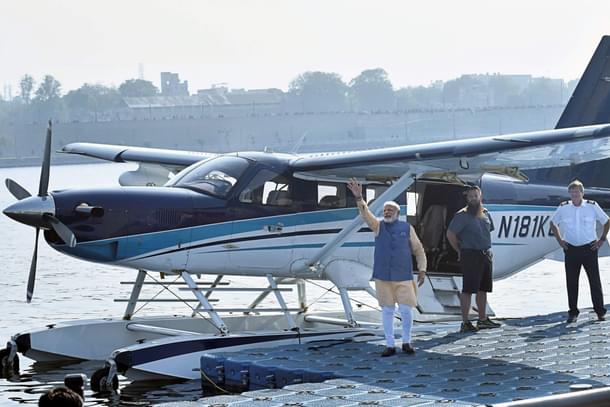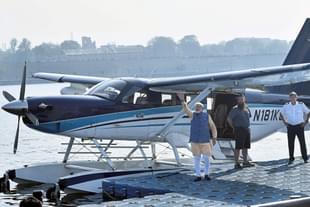Ideas
The Launch Of Seaplane Operations In Gujarat May Pave Way For Specialised Infrastructure Development
Satyendra Pandey
Oct 27, 2020, 11:54 AM | Updated 11:52 AM IST
Save & read from anywhere!
Bookmark stories for easy access on any device or the Swarajya app.


The anniversary of Sardar Vallabhbhai Patel, the man who integrated the diverse states to build present-day India, falls on 31 October.
As we celebrate this glorious legacy of Patel — the first deputy prime minister of India — this year, the country will witness the launch of commercial seaplane operations between the Sabarmati riverfront in Ahmedabad and the Statue of Unity (in honour of Sardar Patel) in Kevadia.
The journey of 200 kilometres will be covered in 45 minutes with seaplanes flying six to eight trips per day. It is a moment several have been eagerly waiting for as it may just well lay the case for the potential for seaplane operations in India.
Seaplane operations are unique and carry with them their own demands for specialised infrastructure.
First, there is a critical requirement for sustainable water aerodromes. These have to be easily accessible and charges must commensurate with the scale of operations. Then there are considerations such as the depth of the sea bed and the length of run required for takeoffs and landings have to be catered for.
The current flow, water levels, wave heights have to be measured. Presence of animals such as crocodiles or species of fish has to be mitigated. Items such as water debris also have to be accounted for. The approach to landing sites has unobstructed and come under navigable airspace… the list goes on.
Other variables include development of staff and pilots, hangar facilities, operating space and docks. In the Indian context, all of these are ‘greenfield setups’. That is, they have to be developed from scratch as opposed to expanding existing infrastructure. That poses unique challenges of its own including the will and skill for such an undertaking.
It is no surprise that the launch of this service finds place in the state of Gujarat as it requires multiple stakeholders to align and the ability of the state to drive consensus. This is further complicated by the fact that aviation remains a subject under the Centre but most of the infrastructure development and support has to come from the state.
On the operations side, in addition to the aircraft, there is the regular passenger handling and limited cargo handling often impacted by payload limitations. Additional provisions have to be made for docking and securing aircraft.
Getting fuel to a water-aerodrome is a challenge of its own. As is the ability to get passengers and personnel in and out of facilities. Finally, water-based operations require intensive maintenance for the fleet and this has to be provisioned and planned for.
With regards to safety, emergency services including firefighting and rescue have to be planned for. One immediately thinks of trucks and ambulances for these services, but in the case of seaplanes in many cases the aircraft has to be accessed via boats. Thus boats have to be retrofitted as fire-boats and ambulances.
Other limiting factors include the ability to only operate from sunrise to sunset. This is not unique to India. While there are a few facilities in the world that do accommodate night seaplane landings such as the landing lane on Lake Hood in Anchorage, Alaska, that is the exception not-the norm.
These unique requirements translate into risk which in turn translates into higher costs. The ability to recover the costs is limited and thus the decision of the government to bring these services under the UDAN scheme – a scheme by the government of India which helps with waivers on costs and also subsidies on airfares to flights between unserved and underserved destinations. The scheme is mostly funded by a fee on travellers flying between metro cities.
Finally, there is the ecological challenge. This, perhap,s poses the greatest challenge to seaplane operations in terms of managing stakeholder expectations with regards to environmental and ecological concerns.
In the past, there have been concerns on fishing communities that can be impacted. There is also the challenge of biodiversity. Noise levels and disturbance of existing natural habitats is also a case made by some.
The Kerala government has already faced challenges on this front and initially set up and then dismantled aerodromes at Punnamada, Kumarakom, Ashtamudi and Bakel. The assets in these locations were redeployed for the promotion of adventure tourism.
Recent protests and decisions with regards to the Aarey forest in Mumbai also bring up several parallels. But often there is a gap between perception and reality and the fact of the matter is that seaplane operations when done the right way continue to deliver for communities and even countries in many parts of the world.
Overall, seaplanes require specialised infrastructure both during development and operation. It is no wonder then that the Maldivian Aero — a part of the national airline of Maldives and owned by the government of Maldives — is assisting in the launch of seaplane operations in Gujarat.
The success of this operation may indeed pave way for other projects, where the Indian government has made a strong push. This includes development of inland waterways towards the viability of seaplane operations.
Policy initiatives include the Directorate General of Civil Aviation (DGCA) issuing licensing norms for setting up water aerodromes. This was followed by the Airports Authority of India assessing upto 20 sites last year and inclusion of seaplane operations in the regional connectivity scheme (UDAN) making these eligible for subsidies and waivers. Other policy initiatives are also likely to emerge.
Going forward, additional sites that may see seaplane operations include the Shatrunjay Dam in Gujarat, Umrangso Reservoir and the riverfront in Guwahati, the Tehri Dam in Uttarakhand, the Erai and Khindi Dam in Maharashtra, in addition to the Mumbai waterfront, Nagarjuna Sagar in Telangana and various sites in Andaman and Nicobar Islands. And if a majority prove to be successful, other states are almost certain to follow.
With 4 lakh ponds in India, numerous dams, 2,000 river ports, 200 small ports and 12 major ports, the potential is large. One can only wait and watch to see whether the launch of seaplane operations in Gujarat translates to financial, commercial and strategic success. With that it may just pave way for specialised infrastructure development across the country.
Satyendra Pandey is an India market expert and has held a variety of roles within aviation. His positions include working as the Head of Strategy & Planning at Go Airlines (India) and with CAPA (Centre for Aviation) where he led the Advisory and Research teams. He is also a certified pilot with an instrument rating.
Satyendra Pandey is an India market expert and has held a variety of roles within the aviation business. His positions include working as the Head of Strategy & Planning at Go Airlines (India) and with CAPA (Centre for Aviation) where he led the Advisory and Research teams. He is also a certified pilot with an instrument rating.





